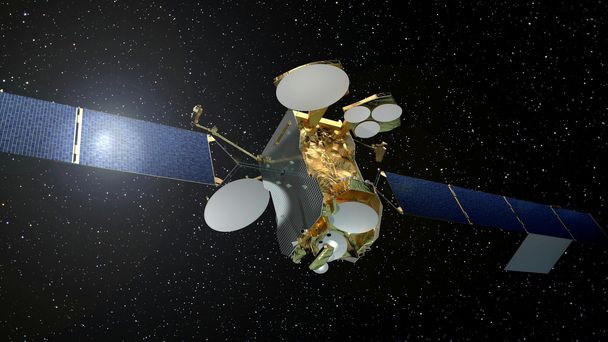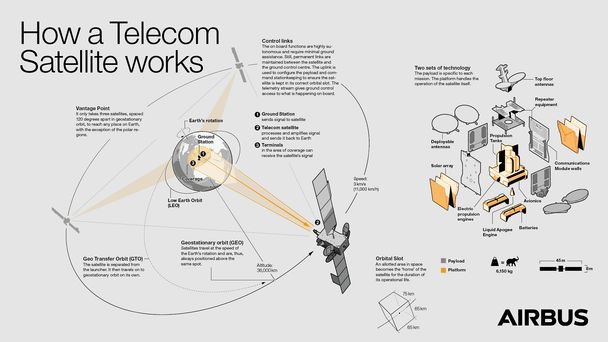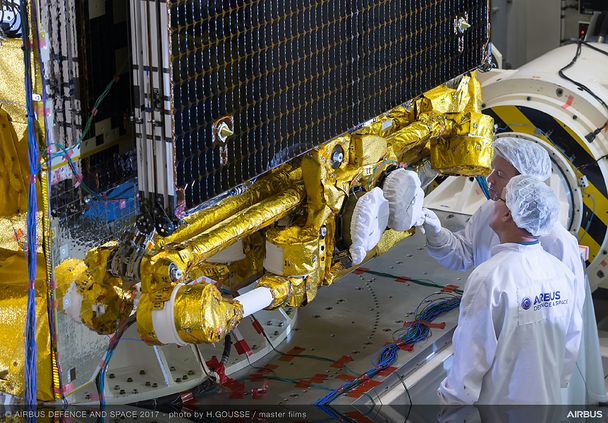All-electric propulsion satellites

Sparking a revolution in space
The launch of Eutelsat 172B signals the rise of the electric age for satellite operations. Airbus is at the forefront of this new journey towards more competitive telecommunications satellite systems.
“With this spacecraft we are clearly setting a new benchmark,” Nicolas Chamussy, Head of Space Systems at Airbus, proclaimed as Eutelsat 172B soared into space.
The satellite, built by Airbus and launched on 2 June 2017, represents an industry first. It is the first high-power all-electric telecommunications satellite in the world.
Leading the race
Airbus has more than 12 years’ experience in using electric propulsion for satellite on-station manoeuvres and is now leading the race for high-power all-electric satellites: These employ electric propulsion for an even wider range of operations, while cutting fuel consumption and thereby reducing launch mass by 40%.
“We currently have 10 satellites using electric propulsion for station-keeping in orbit, and 6 all-electric satellites already ordered, making us the world leader in this domain,” says engineer Gérard Berger, marketing manager for Airbus telecommunications satellites.
“Furthermore we are the first in the world to adopt electric propulsion for raising the orbit [Electric Orbit Raising, EOR] for large and powerful satellites. The few all-electric satellites already in orbit have modest capacity compared with the satellites we usually build,” explains Berger.
50% of telecommunications satellites might use electric propulsion in the short run

Simpler, lighter and safer
Eutelsat 172B is the first high-power satellite in the 3-tonne class. SES-12, also based on Airbus’ ultra-reliable Eurostar platform in its E3000e variant, will be launched at the end of 2017. SES-14, currently under construction, will be the first high-power all-electric satellite in the 4-tonne class.
Electric satellites are simpler, lighter and safer. Without the need for heavy chemical propellant, the satellite can have a lower mass and therefore lower launch price, as such costs are in direct relation with mass. Operations are also safer at the launch site, because fuelling the satellite is unnecessary, and the mass savings can also be traded for a larger payload, thereby increasing mission capacity.
However, electric propulsion systems provide less thrust than their chemical counterparts and it takes three to six months to reach geostationary orbit, as opposed to one week using chemical propulsion. “For Eutelsat 172B it will be four months, less time than has been needed so far, because we are using a relatively higher thrust technology known as Hall Effect Thrusters,” Berger adds.
With full electric propulsion, tonnes of chemical propellant are replaced by a system that requires less than a fifth of the mass, in the form of xenon gas. This gas is ionised and accelerated in an electric field, and it can be ejected at very high speed using only electric power supplied by solar cells. This creates the thrust that moves the spacecraft.
- 6 all-electric satellites already ordered
- 12 years’ experience in using electric propulsion for satellite on-station manoeuvres
New journeys into space
“We have changed the paradigm of electric propulsion systems, which were originally meant for small satellites. Using the scale effect, we are offering more payload on one satellite, equivalent to two missions. We have all the energy needed to reach orbit thanks to the satellites’ large solar arrays,” explains Berger.
Electric propulsion systems are key to enable new missions, expanding the limits of reachable space. Subsequently, this technology will boost growth in areas such as telecommunications, space exploration, human flight, science or Earth observation, according to the European Space Agency (ESA).
Electric propulsion is set for Europe’s first mission to Mercury; BepiColombo, a multi-spacecraft mission to explore the planet in unprecedented detail, is to be launched in late 2018. Airbus is responsible for designing and building the European Mercury Planetary Orbiter (MPO) and the Mercury Transfer Module.
LISA Pathfinder is also making use of electric propulsion orbiting the L1 point, some 1.5 million kilometres from Earth, on its mission to explore the existence of gravitational waves.
“We have changed the paradigm of electric propulsion systems,” Gérard Berger

On a mission
Industry forecasts suggest that in the short run at least 50% of telecommunications satellites might use electric propulsion. ESA’s NEOSAT programme – which targets developing and validating in orbit next-generation platforms – aims to help European satellite builders capture at least half of the world’s satcom market in 2018–30, generating €25 billion in sales.
Another goal is to reduce, by the end of the decade, the cost of a satellite in orbit by 30% compared with today’s spacecraft. Airbus, as the first manufacturer in the world to offer full electric propulsion for high-power and high-capacity missions, is at the forefront in achieving this goal.
Manuel Ansede